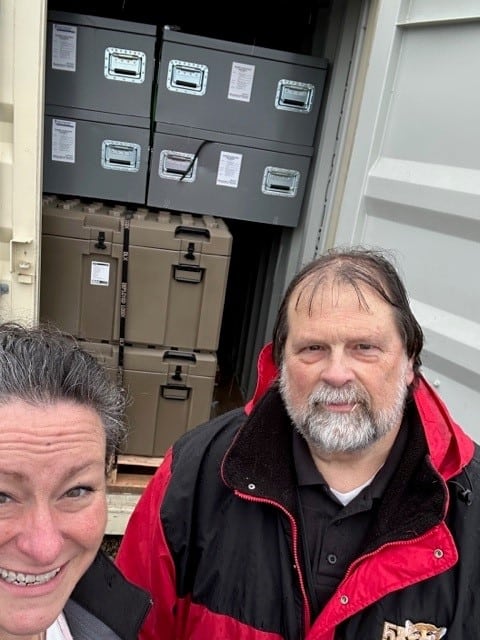(Tillamook) – To help Tillamook County prepare for a Cascadia earthquake event, the Oregon Department of Human Services (ODHS), Office of Resilience and Emergency Management delivered two large portable cargo containers filled with emergency relief supplies and equipment to the Tillamook Municipal Airport.
These containers, called Conex boxes, were delivered in April and are part of an emergency preparedness partnership between ODHS, Tillamook County, Tillamook Municipal Airport and Near Space Corporation.
“Coastal communities like Tillamook are prioritized to house these Conex boxes because data shows they are likely to be cut off from the rest of the state during the Cascadia earthquake,” said Ed Flick (he/him), director of the ODHS Office of Resilience and Emergency Preparedness. “ODHS has primary responsibility for mass care and shelter following disasters, so helping local communities access critical supplies that can quickly be used to serve their local community is important to us.”
A section of the Tillamook Municipal Airport is designated as an evacuation assembly point for Tillamook County. The Conex boxes are stocked with food, water, tents and medical supplies to support 100 people at the evacuation assembly point for two weeks in the event of an emergency. Conex boxes are tan or rust colored containers that are 20-feet long and 8-feet wide.
Evacuation assembly points are short-term locations for people to gather while emergency responders work to access the impacted area. They are not intended to be long-term shelters but are places people can register, receive nourishment and short-term shelter, get essential medical care and be scheduled for transport out of the area when needed.
The Conex boxes and the emergency supplies in them are being provided to Tillamook County at no cost.
There will also be a series of training sessions to ensure emergency preparedness officials in Tillamook County are familiar with how to use and deploy the provided supplies during an emergency.
“Tillamook County is grateful to ODHS for supporting our community’s emergency preparedness efforts in this way,” said Randy Thorpe (he/him), Tillamook County emergency management director. “Having these critical and lifesaving emergency supplies immediately available at an evacuation assembly point will help our community respond to and recover from a mass disaster like a Cascadia earthquake event.
Michele Bradley (she/her), general manager at Port of Tillamook Bay where the airport is located, is involved with emergency management planning in Tillamook County and collaborated with Thorpe to identify the best location for the Conex boxes and supplies to be stored. They determined that a location close to Near Space Corporation at the airport would be best.
“I’ve been a part of work groups on resilience after a disaster,” said Bradley. “I wanted us to be part of the solution. The airport is a good location, and it makes sense to work with the state on this. We could easily serve the seven cities and unincorporated areas in Tillamook County from this location.”
Near Space Corporation tests and flies unmanned aerial vehicles such as drones for the Federal Aviation Administration. Kevin Tucker, president of Near Space Corporation also has experience in emergency preparedness planning.
“With our unmanned aerial vehicle testing and operations we are very much involved with emergency management and disaster preparedness,” said Tucker. “We want to make sure we are doing everything we can for preparedness. We want to help all we can. It’s pretty much just being a good citizen.”
Anyone who wants to learn more about how to prepare for emergencies can find resources at www.ready.gov<http://www.ready.gov/>.
About the ODHS Office of Resilience and Emergency Management
ODHS holds three distinct roles through its Office of Resilience and Emergency Management, all of which reduce the impact of disasters on people. In its most foundational role, OREM staff work every day with ODHS programs, offices and affiliated agencies to ensure the safety of the people served by our programs, and our staff. The second role is as the lead agency for cooling, warming and cleaner air centers to protect the public from life-threatening weather and related events. The third role is as the primary agency for mass care and social services recovery, as outlined in Oregon’s comprehensive emergency operations and recovery plans. In this role, ODHS supports the evacuation, sheltering, feeding, emergency assistance, family reunification, distribution of emergency supplies and human services needs of people impacted by disasters.
Across all these roles, ODHS develops and relies on partnerships and coordination with public and private organizations at the local and regional levels and with our state and Tribal Nation partners.


.png)